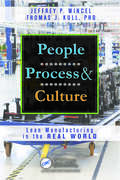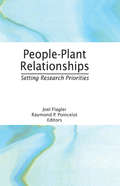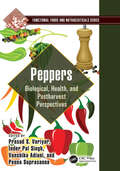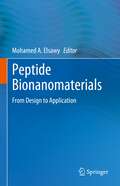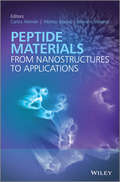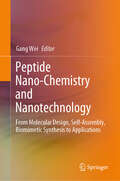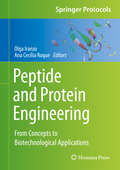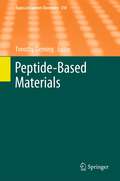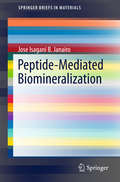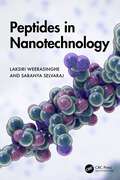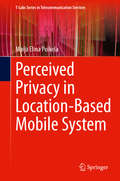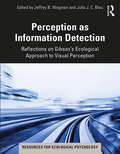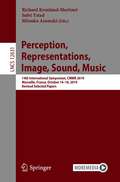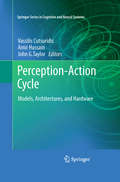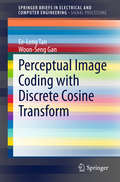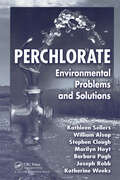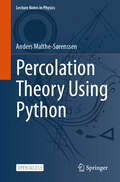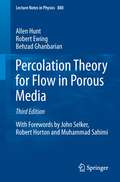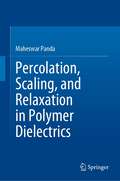- Table View
- List View
People, Process, and Culture: Lean Manufacturing in the Real World
by Jeffrey P. Wincel Thomas J. Kull, PhDExamining Lean processes in the context of the authors’ academic research in-progress, People, Process, & Culture: Lean Manufacturing in the Real World illustrates the impact of culture on the implementation of Lean Manufacturing (LM) across various geographic and cultural areas. It identifies cultural values, as examined against Lean manufacturing disciplines, and derives culturally based Lean Manufacturing (LM) values. It then assesses these cultural values in light of specific LM components, such as PULL systems and TPM, to demonstrate varying perspectives and applications. Illustrates global cultural influences on Lean implementation Uses academic research as the foundation of the material Examines the many Lean components currently in use around the world Building on the continued prominence of LM as the preferred operational approach, the book supplies time-tested advice to help you sort through the flood of information on Lean techniques and culture. It examines the numerous Lean components currently being deployed successfully around the world and identifies the limitations that can result from the varying interpretations and applications of Lean systems.Lean culture is all about Lean vision, mission, and values. This book not only identifies the Lean values required, but also supplies the understanding to integrate these values across all levels of your organization. The book will be especially helpful to international corporate managers working to demystify the sometimes hard-to-understand characteristics of Lean transformation.
People-Plant Relationships: Setting Research Priorities
by Joel Flagler Raymond P PoincelotPresenting the latest research on cross-cultural people-plant relationships, this volume conveys the psychological, physiological, and social responses to plants and the significant role these responses play in improved physical and mental health. With chapters written by field experts, it identifies research priorities and methodologies and outlines the steps for developing a research agenda to aid horticulturalists in their work with social scientists to gain a better understanding of people-plant relationships. This resource covers a wide array of topics including home horticulture and Lyme disease, indoor plants and pollution reduction, and plants and therapy.
People-Powered: Pedaling on Land, Sea, and Air (Fountas & Pinnell LLI Gold #Level O)
by Judith Lechner<p>Power Up! <p>New forms of transportation are changing the way people get around. Some new vehicles don't run on gas--they run on human energy. And they go everywhere: on land, on sea, and into the sky! <p>Text Elements: <p> <li>Genre: Nonfiction, Expository <li>Text Structures: Main: Categorical, Embedded: Description, Problem/Solution, Cause/Effect <li>Text Features: table of contents, headings, photos, captions, sidebars, glossary</li> </p>
Peppers: Biological, Health, and Postharvest Perspectives (Functional Foods and Nutraceuticals)
by Penna Suprasanna Prasad S. Variyar Vanshika Adiani Inder Pal SinghThere is an increased awareness on the relevance of nutraceutical and functional foods as alternatives to harmful synthetic additives used in industry. Different peppers, with an abundance of bioactive compounds, are highlighted in this book, which provides a comprehensive evaluaton of their importance as nutraceutical and functional foods to all stakeholders in the agri-food and pharmaceutical industries. Peppers: Biological, Health, and Postharvest Perspectives is a valuable addition to the existing information resource on peppers.Key features: Highlights the advancements made in biodiversity, biochemistry and biosynthesis of bioactive compounds of peppers. Reviews the effects of processing methods on the quality of peppers to facilitate further research and development of foods having pepper as an essential nutritional component. Provides help in selecting better processing methods for the management of nutritional attributes and health benefits of peppers. The book provides a blend of basic and advanced information for postgraduate students, researchers and scientists
Peptide Bionanomaterials: From Design to Application
by Mohamed A. ElsawyMolecular self-assembly has been exploited by nature for developing the higher functional macromolecular structures of both the genome and proteome. Inspired by nature, there has been a surge of research, in the last two decades, for the molecular engineering of peptide-based self-assembling nanostructures, adopting the bottom-up design approach. This book gives the reader an overview on the design rules for de novo self-assembling peptide and reviews the diverse range of bioinspired peptide nanostructures such as β-sheet and β-hairpin, α-helical and coiled coil, self-assembling short peptides and peptidomimetics, collagen-based and elastin-like peptides, silk peptides, peptide amphiphiles, peptides co-polymers and others. The book also covers the wide variety of responsive and functional biomaterials that have been innovated based on those nanostructures for various applications ranging from tissue engineering, therapeutics and drug delivery to antimicrobial nanomaterials and biosensors. Finally, the book also discusses the peptide bionanomaterials global market and the future of the emerging industry.Chapter “Characterization of Peptide-Based Nanomaterials” is available open access under a Creative Commons Attribution 4.0 International License via link.springer.com.
Peptide Macrocycles: Methods and Protocols (Methods in Molecular Biology #2371)
by Matthew B. Coppock Alexander J. WintonThis volume explores the latest techniques and strategies used to study the field of peptide macrocycles. The chapters in this book ae organized into four parts: macrocycles synthesis, combinational library synthesis and screening, macrocycle characterization, and unique applications. Part One looks at a variety of peptide cyclization methodologies, and Part Two describes methods for the creation of peptide macrocycles libraries and their subsequent screening against biological targets of interest. Part Three discusses the study and characterization of peptide macrocycle-target interactions, and Part Four introduces unique applications for peptide macrocycles, from higher-order structure formation to post-synthetic functional modifications. Written in the highly successful Methods in Molecular Biology series format, chapters include introductions to their respective topics, lists of the necessary materials and reagents, step-by-step, readily reproducible laboratory protocols, and tips on troubleshooting and avoiding known pitfalls. Cutting-edge and comprehensive, Peptide Macrocycles: Methods and Protocols is a valuable resource for both novice and expert researchers looking to learn more about this developing field.
Peptide Materials
by Alberto Bianco Carlos Aleman Mariano VenanziPeptides are the building blocks of the natural world; with varied sequences and structures, they enrich materials producing more complex shapes, scaffolds and chemical properties with tailorable functionality. Essentially based on self-assembly and self-organization and mimicking the strategies that occur in Nature, peptide materials have been developed to accomplish certain functions such as the creation of specific secondary structures (a- or 310-helices, b-turns, b-sheets, coiled coils) or biocompatible surfaces with predetermined properties. They also play a key role in the generation of hybrid materials e.g. as peptide-inorganic biomineralized systems and peptide/polymer conjugates, producing smart materials for imaging, bioelectronics, biosensing and molecular recognition applications.Organized into four sections, the book covers the fundamentals of peptide materials, peptide nanostructures, peptide conjugates and hybrid nanomaterials, and applications with chapters including:Properties of peptide scaffolds in solution and on solid substratesNanostructures, peptide assembly, and peptide nanostructure designSoft spherical structures obtained from amphiphilic peptides and peptide-polymer hybridsFunctionalization of carbon nanotubes with peptidesAdsorption of peptides on metal and oxide surfacesPeptide applications including tissue engineering, molecular switches, peptide drugs and drug deliveryPeptide Materials: From Nanostructures to Applications gives a truly interdisciplinary review, and should appeal to graduate students and researchers in the fields of materials science, nanotechnology, biomedicine and engineering as well as researchers in biomaterials and bio-inspired smart materials.
Peptide Nano-Chemistry and Nanotechnology: From Molecular Design, Self-Assembly, Biomimetic Synthesis to Applications
by Gang WeiThis book presents the progress in functional peptides in the fields of nano-chemistry and nanotechnology. It covers the synthesis and properties of peptides, functionalization and hybridization of peptides, and applications of peptide-based nanomaterials. The first section provides an overview of the self-assembly of designed peptides to 1D, 2D, and 3D nanostructures. This is followed by the introduction of the hybridization of peptides with polymers, nanoparticles, carbon materials, and 2D materials through specific binding and biomimetic synthesis to create bioactive nanomaterials. Finally, the book highlights the applications of peptide-based nanomaterials in materials science, nanotechnology, and biomedicine. This book helps readers to understand the chemical, physical, and biological properties of peptides and further inspire the design and synthesis of functional peptide nanomaterials for advanced applications.
Peptide and Protein Engineering: From Concepts to Biotechnological Applications (Springer Protocols Handbooks)
by Olga Iranzo Ana Cecília RoqueThis thorough book aims to present the methods that have enabled the success of peptides and proteins in a wide variety of applications. It opens with a section on chemical tools applied to the production or engineering of peptides and proteins, and concludes with a collection of chapters on biological approaches used to engineer structure and function in peptides and proteins. As a book in the Springer Protocols Handbooks series, chapters include the kind of detailed descriptions and tips necessary for successful results in practice. Authoritative and practical, Peptide and Protein Engineering: From Concepts to Biotechnological Applications will be of great use to scientists in academia and industry seeking a better understanding of the emerging principles and methodologies in peptide and protein engineering.
Peptide-Based Materials
by Timothy DemingSynthesis of Polypeptides by Ring-Opening Polymerization of α-Amino Acid N-Carboxyanhydrides, by Jianjun Cheng and Timothy J. Deming.- Peptide Synthesis and Self-Assembly, by S. Maude, L. R. Tai, R. P. W. Davies, B. Liu, S. A. Harris, P. J. Kocienski and A. Aggeli.- Elastomeric Polypeptides, by Mark B. van Eldijk, Christopher L. McGann, Kristi L. Kiick andJan C. M. van Hest.- Self-Assembled Polypeptide and Polypeptide Hybrid Vesicles: From Synthesis to Application, by Uh-Joo Choe, Victor Z. Sun, James-Kevin Y. Tan and Daniel T. Kamei.- Peptide-Based and Polypeptide-Based Hydrogels for Drug Delivery and Tissue Engineering, by Aysegul Altunbas and Darrin J. Pochan.-
Peptide-Mediated Biomineralization
by Jose Isagani B. JanairoThis book describes recent advances in peptide-mediated biomineralization and how this method was able to create improved catalysts through minor tweaks in the system. The book is thorough in its discussion which will be appreciated by beginners such as advanced undergraduate students. The topics covered are very recent which will raise the interest of experts. The book is envisioned to become a "one-stop-shop" for peptide mediated biomimetic material synthesis by discussing the most recent and most relevant topics related to biomineralization. The book attempts to discuss biomineralization from different perspectives in order to provide a multi-disciplinary treatment to the subject. Aside from being a reference material, this book can also serve as a manual to guide researchers engaged in the field since the chapters contain sections describing experimental procedures. The book also contains high quality illustrations and images that will surely add depth and clarity in the discussion.
Peptides in Nanotechnology
by Laksiri Weerasinghe Saranya SelvarajAmong the various nanomaterials, peptides have emerged as a promising tool due to their unique properties such as high specificity, biocompatibility, and low toxicity. This book provides a comprehensive overview of the field of peptide-based nanomaterials, from their synthesis to their applications. It covers the latest advancements in peptide nanotechnology and provides detailed insights into various aspects of peptide-based nanomaterials, including their properties, synthesis, characterization, and potential applications in various biomedical fields.Features: Provides up-to-date detailed descriptions of various peptide-based nanostructures and their formation. Covers a wide range of topics related to peptides in nanotechnology including their synthesis and characterization. Includes the latest research and developments in the field of peptides in nanotechnology. Contains recent applications in drug delivery, tissue engineering, imaging and diagnostics, and targeted cancer therapy. Reviews peptide-nanoparticle conjugates (PNCs). This book is aimed at graduate students and researchers in peptide synthesis, biomedical engineering, and drug development and delivery.
Pequeños robots malvados
by Damien LoveMagia, robots y peligro... ¿qué puede salir mal? Un día de invierno, Alex recibe un misterioso regalo de su abuelo: un pequeño robot con una nota que dice "este es especial". Extraños sucesos comienzan a tener lugar, y Alex sospecha que su nuevo robot, más que especial, puede ser... ¿mortal? Damien Love vive en la ciudad de Glasgow, donde probablemente llueva mientras lees estas palabras. Ha trabajado como periodista durante muchos años, escribiendo sobre películas, música, televisión y otras cosas para una variedad de publicaciones, entre las cuales destacan The Sunday Herald, The Guardian y The Scotsman. Tiene la capacidad de hablar con los gatos, pero no hay evidencia de que lo entiendan. Pequeños robots malvados es su primera novela, un fascinante despliegue de imaginación y acción que te tendrá pegado a sus páginas.
Perceived Privacy in Location-Based Mobile System (T-Labs Series in Telecommunication Services)
by Maija Elina PoikelaThis work aims at understanding behavior around location information, including why users share such information, why they protect the data, and what kind of other factors influence the decision to behave in a certain way. This book explores privacy in the context of location data, and answers questions such as what are the privacy related behaviors in this context, and what are the factors influencing such behaviors. The book gives an overview to what privacy means for users in terms of understandings, attitudes and valuations. This book discusses reasons for why research around this topic is challenging, and presents various methods for diving into the topic through empirical studies. The work is relevant for professionals, researchers, and users of technology.
Perception as Information Detection: Reflections on Gibson’s Ecological Approach to Visual Perception (Resources for Ecological Psychology Series)
by Jeffrey B. Wagman Julia J. C. BlauThis book provides a chapter-by-chapter update to and reflection on of the landmark volume by J.J. Gibson on the Ecological Approach to Visual Perception (1979). Gibson’s book was presented a pioneering approach in experimental psychology; it was his most complete and mature description of the ecological approach to visual perception. Perception as Information Detection commemorates, develops, and updates each of the sixteen chapters from Gibson’s volume. The book brings together some of the foremost perceptual scientists in the field, from the United States, Europe, and Asia, to reflect on Gibson’s original chapters, expand on the key concepts discussed and relate this to their own cutting-edge research. This connects Gibson’s classic with the current state of the field, as well as providing a new generation of students with a contemporary overview of the ecological approach to visual perception. Perception as Information Detection is an important resource for perceptual scientists as well as both undergraduates and graduates studying sensation and perception, vision, cognitive science, ecological psychology, and philosophy of mind.
Perception as Information Detection: Reflections on Gibson’s Ecological Approach to Visual Perception (Resources for Ecological Psychology Series)
by Jeffrey B. Wagman Julia J. C. BlauThis book provides a chapter-by-chapter update to and reflection on of the landmark volume by J.J. Gibson on the Ecological Approach to Visual Perception (1979).Gibson’s book was presented a pioneering approach in experimental psychology; it was his most complete and mature description of the ecological approach to visual perception. Perception as Information Detection commemorates, develops, and updates each of the sixteen chapters from Gibson’s volume. The book brings together some of the foremost perceptual scientists in the field, from the United States, Europe, and Asia, to reflect on Gibson’s original chapters, expand on the key concepts discussed and relate this to their own cutting-edge research. This connects Gibson’s classic with the current state of the field, as well as providing a new generation of students with a contemporary overview of the ecological approach to visual perception.Perception as Information Detection is an important resource for perceptual scientists as well as both undergraduates and graduates studying sensation and perception, vision, cognitive science, ecological psychology, and philosophy of mind.
Perception, Representations, Image, Sound, Music: 14th International Symposium, CMMR 2019, Marseille, France, October 14–18, 2019, Revised Selected Papers (Lecture Notes in Computer Science #12631)
by Mitsuko Aramaki Richard Kronland-Martinet Sølvi YstadThis book constitutes the refereed proceedings of the 14th International Symposium on Perception, Representations, Image, Sound, Music, CMMR 2019, held in Marseille, France, in October 2019. The 46 full papers presented were selected from 105 submissions. The papers are grouped in 9 sections. The first three sections are related to music information retrieval, computational musicology and composition tools, followed by a section on notations and instruments distributed on mobile devices. The fifth section concerns auditory perception and cognition, while the three following sections are related to sound design and sonic and musical interactions. The last section contains contributions that relate to Jean-Claude Risset's research.
Perception-Action Cycle
by Amir Hussain Vassilis Cutsuridis John G. TaylorThe perception-action cycle is the circular flow of information that takes place between the organism and its environment in the course of a sensory-guided sequence of behaviour towards a goal. Each action causes changes in the environment that are analyzed bottom-up through the perceptual hierarchy and lead to the processing of further action, top-down through the executive hierarchy, toward motor effectors. These actions cause new changes that are analyzed and lead to new action, and so the cycle continues. The Perception-action cycle: Models, architectures and hardware book provides focused and easily accessible reviews of various aspects of the perception-action cycle. It is an unparalleled resource of information that will be an invaluable companion to anyone in constructing and developing models, algorithms and hardware implementations of autonomous machines empowered with cognitive capabilities. The book is divided into three main parts. In the first part, leading computational neuroscientists present brain-inspired models of perception, attention, cognitive control, decision making, conflict resolution and monitoring, knowledge representation and reasoning, learning and memory, planning and action, and consciousness grounded on experimental data. In the second part, architectures, algorithms, and systems with cognitive capabilities and minimal guidance from the brain, are discussed. These architectures, algorithms, and systems are inspired from the areas of cognitive science, computer vision, robotics, information theory, machine learning, computer agents and artificial intelligence. In the third part, the analysis, design and implementation of hardware systems with robust cognitive abilities from the areas of mechatronics, sensing technology, sensor fusion, smart sensor networks, control rules, controllability, stability, model/knowledge representation, and reasoning are discussed.
Perceptions and Analysis of Digital Risks
by Camille Capelle Vincent LiquèteThe concept of digital risk, which has become ubiquitous in the media, sustains a number of myths and beliefs about the digital world. This book explores the opposite view of these ideologies by focusing on digital risks as perceived by actors in their respective contexts.Perceptions and Analysis of Digital Risks identifies the different types of risks that concern actors and actually impact their daily lives, within education or various socio-professional environments. It provides an analysis of the strategies used by the latter to deal with these risks as they conduct their activities; thus making it possible to characterize the digital cultures and, more broadly, the informational cultures at work.This book offers many avenues for action in terms of educating the younger generations, training teachers and leaders, and mediating risks.
Perceptual Digital Imaging: Methods and Applications (Digital Imaging and Computer Vision #6)
by Rastislav LukacVisual perception is a complex process requiring interaction between the receptors in the eye that sense the stimulus and the neural system and the brain that are responsible for communicating and interpreting the sensed visual information. This process involves several physical, neural, and cognitive phenomena whose understanding is essential to design effective and computationally efficient imaging solutions. Building on advances in computer vision, image and video processing, neuroscience, and information engineering, perceptual digital imaging greatly enhances the capabilities of traditional imaging methods. Filling a gap in the literature, Perceptual Digital Imaging: Methods and Applications comprehensively covers the system design, implementation, and application aspects of this emerging specialized area. It gives readers a strong, fundamental understanding of theory and methods, providing a foundation on which solutions for many of the most interesting and challenging imaging problems can be built. The book features contributions by renowned experts who present the state of the art and recent trends in image acquisition, processing, storage, display, and visual quality evaluation. They detail advances in the field and explore human visual system-driven approaches across a broad spectrum of applications, including: Image quality and aesthetics assessment Digital camera imaging White balancing and color enhancement Thumbnail generation Image restoration Super-resolution imaging Digital halftoning and dithering Color feature extraction Semantic multimedia analysis and processing Video shot characterization Image and video encryption Display quality enhancement This is a valuable resource for readers who want to design and implement more effective solutions for cutting-edge digital imaging, computer vision, and multimedia applications. Suitable as a graduate-level textbook or stand-alone reference for researchers and practitioners, it provides a unique overview of an important and rapidly developing research field.
Perceptual Image Coding with Discrete Cosine Transform
by Ee-Leng Tan Woon-Seng GanThis book first introduces classic as well as recent computational models for just-noticeable-difference (JND) applications. Since the discrete cosine transform (DCT) is applied in many image and video standards (JPEG, MPEG-1/2/4, H. 261/3), the book also includes a comprehensive survey of computational models for JND that are based on DCT. The visual factors used in these computational models are reviewed in detail. Further, an extensive comparative analysis of these models using quantitative and qualitative performance criteria is presented, which compares the noise shaping performance of these models with subjective evaluation and the accuracy between the estimated JND thresholds and subjective evaluation. There are many surveys available on computational models for JND; however, these surveys seldom compare the performance of computational models that are based on DCT. The authors' survey of the computational models and their in-depth review of the visual factors used in them will help readers understand perceptual image coding based on DCT. The book also provides a comparative analysis of several perceptual image coders that are based on DCT, which are compatible with the highly popular and widely adopted JPEG standard.
Perchlorate: Environmental Problems and Solutions
by Kathleen Sellers Katherine Weeks William R. Alsop Stephen R. Clough Marilyn Hoyt Barbara Pugh Joseph RobbThe development of analytical methods for identifying widespread perchlorate contamination brought about an explosion of research into the environmental problems and their potential solutions along with a corresponding increase in the availability of information. Unlike reference works that focus on only a few aspects of this contaminant, Perchlora
Percolation Theory Using Python (Lecture Notes in Physics #1029)
by Anders Malthe-SørenssenThis course-based open access textbook delves into percolation theory, examining the physical properties of random media—materials characterized by varying sizes of holes and pores. The focus is on both the mathematical foundations and the computational and statistical methods used in this field. Designed as a practical introduction, the book places particular emphasis on providing a comprehensive set of computational tools necessary for studying percolation theory. Readers will learn how to generate, analyze, and comprehend data and models, with detailed theoretical discussions complemented by accessible computer codes. The book's structure ensures a complete exploration of worked examples, encompassing theory, modeling, implementation, analysis, and the resulting connections between theory and analysis. Beginning with a simplified model system—a model porous medium—whose mathematical theory is well-established, the book subsequently applies the same framework to realistic random systems. Key topics covered include one- and infinite-dimensional percolation, clusters, scaling theory, diffusion in disordered media, and dynamic processes. Aimed at graduate students and researchers, this textbook serves as a foundational resource for understanding essential concepts in modern statistical physics, such as disorder, scaling, and fractal geometry.
Percolation Theory for Flow in Porous Media
by Allen Hunt Robert Ewing Behzad GhanbarianThis monograph presents, for the first time, a unified and comprehensive introduction to some of the basic transport properties of porous media, such as electrical and hydraulic conductivity, air permeability and diffusion. The approach is based on critical path analysis and the scaling of transport properties, which are individually described as functions of saturation. At the same time, the book supplies a tutorial on percolation theory for hydrologists, providing them with the tools for solving actual problems. In turn, a separate chapter serves to introduce physicists to some of the language and complications of groundwater hydrology necessary for successful modeling. The end-of-chapter problems often indicate open questions, which young researchers entering the field can readily start working on. This significantly revised and expanded third edition includes in particular two new chapters: one on advanced fractal-based models, and one devoted to the discussion of various open issues such as the role of diffusion vs. advection, preferential flow vs. critical path, universal vs. non-universal exponents for conduction, and last but not least, the overall influence of the experimental apparatus in data collection and theory validation. "The book is suitable for advanced graduate courses, with selected problems and questions appearing at the end of each chapter. [. . . ] I think the book is an important work that will guide soil scientists, hydrologists, and physicists to gain a better qualitative and quantitative understanding of multitransport properties of soils. " (Marcel G. Schaap, Soil Science Society of America Journal, May-June, 2006)
Percolation, Scaling, and Relaxation in Polymer Dielectrics
by Maheswar PandaThis book provides a foundational understanding of polymer dielectrics based on percolative composites. It covers the microstructure and physical properties, such as dielectric, electrical, magnetic, and rheological properties, of polymer composites, as well as how these properties can be explained using various theoretical models and spectroscopy techniques, such as dielectric spectroscopy, impedance spectroscopy, and conductivity spectroscopy. The book also discusses non-percolative polymer composites and the suitability of polymer dielectrics for electrical energy storage in various devices. It is intended for graduate students and professionals in fields such as condensed matter physics, applied physics, statistical physics, materials science, polymer science and technology, chemistry, and engineering. It will be particularly useful for physicists, materials scientists, polymer scientists, chemists, engineers, and others interested in the physics and applications of percolative composites based on polymer matrix.
